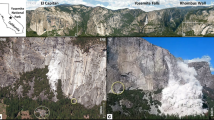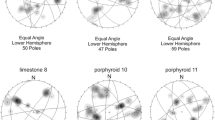Abstract
We present a new approach for mapping open cracks and tension fractures within rock slope instabilities and rock cliffs, which resides in high-resolution ground-based and airborne infrared thermography (IRT). The method is restricted to cold seasons, and its utility is demonstrated through three examples from the Flysch Belt of the Outer West Carpathians (rockslides at Kopce Hill and Mt. Kněhyně) and from the Northern Calcareous Alps (deep-seated gravitational slope deformations in Gschliefgraben/Mt. Traunstein). The approach is based on a contrast between temperatures deep within the rock mass, which at a depth of few meters represent local mean annual values, and winter-time temperatures of the ground surface. In winter, warmer, buoyant air from depth rises to the ground surface through open cracks and joints, and the temperature contrast can be detected by IRT. Our test survey was conducted in the beginning of February 2012, in order to achieve the best contrast between temperatures around open tension cracks and the adjacent ground. For temperature sensing, we used a FLIR B360 thermal camera; for airborne surveys in the ambient air, temperatures at the time of our surveys ranged from approximately −19 to −7 °C. IRT results conclusively revealed the presence of open cracks, loosened rock zones, and pseudo-karst caves over a distance sometimes greater than 1 km. The IRT approach proved useful for rapidly assessing the distribution of open cracks and tension fractures, key information required for assessing rockfall and rockslide hazard.










Similar content being viewed by others
References
Adorno V, Rizzo A (2011) The infrared thermography as a tool to predict muddy-debris flow triggering. Abstract Book of the Second World Landslide Forum, 3–9 October 2011, Rome
Baroň I (2002) Location of underground spaces in selected slope deformations by observations of melted snow and ventaroles (in Czech). Speleofórum 21:64–66
Baroň I, Dobeš P (2000) Results of speleological investigations at Mt. Kopce near Lidečko (in Czech). Speleofórum 19:5–11
Baroň I, Řehák Z (1997) Problematics of winter hibernation of the lesser horseshoe bat (Rhinolophus hipposideros) in the Vsetín region (in Czech). Zpravodaj OVM 1997:3–12
Baroň I, Cílek V, Krejčí O, Melichar R, Hubatka F (2004) Structure and dynamics of deep-seated slope failures in the Magura Flysch Nappe, Outer Western Carpathians (Czech Republic). Nat Hazards Earth Syst Sci 4:549–562
Carter AJ (2008) Quantitative thermal infrared analyses of volcanic processes and products: application to Bezymianny Volcano, Russia. MS. Ph.D. Thesis, University of Pittsburg 171 pp
Cehlin M, Moshfegh B and Sandberg M (2000) Visualization and measuring of air temperatures based on infrared thermography. In: Proceedings of 7th international conference on air distribution in rooms, ROOMVENT 2000, Reading, UK, 9–12 July
DeWitt N (1988) Theory and practice of radiation thermometry. Wiley, New York, 1152
Gischig VS, Moore JR, Evans KF, Amann F, Loew S (2011) Thermomechanical forcing of deep rock slope deformation: 1. Conceptual study of a simplified slope. J Geophys Res 116(F04010):18. doi:10.1029/2011JF002006
Hasler A, Gruber S, Haeberli W (2011) Temperature variability and offset in steep alpine rock and ice faces. Cryosphere 5:977–988
Hong S, Miller TW, Borchers B, Hendrickx JMH, Lensen HA, Schwering PBW, van den Broek SP (2002) Land mine detection in bare soils using thermal infrared sensors. In: Broach JT, Harmon RS, Dobeck GJ (eds) Detection and remediation technologies for mines and minelike targets VII. SPIE proceedings volume 4742., pp 43–50
Kastberger G, Stachl R (2003) Infrared imaging technology and biological applications. Behav Res Meth Instr 35:429–439
Kononov VA (2000) Pre-feasibility investigation of infrared thermography for the identification of loose hanging wall and impending falls of ground. Safety in Mines Research Advisory Committee, GAP 706, September 2000, pp 1–26
Krejčí O, Hubatka F, Švancara J (2004) Gravitational spreading of the elevated mountain ridges in the Moravian-Silesian Beskids. Acta Geodynamica Geomaterialia 3:1–13
Lešinský G (1999) Comments to caving in winter season with focus on observing melted spots and ventaroles (in Slovak). Spravodaj SSS 1999(4):32–33, Liptovský Mikuláš
Margielewski W, Urban J (2003) Crevice-type caves as initial forms of rock landslide development in the Flysch Carpathians. Geomorphology 54(3–4):325–338
Meola C, Carlomagno GM (2004) Recent advances in the use of infrared thermography. Meas Sci Technol 15:27–58
Mogato M, Macfie N (2012) Death toll in Philippines earthquake rises to 35. Reuters, Internet open source, published on Friday, February 10, 2012 at 5:51 am GMT at http://af.reuters.com/article/worldNews/idAFTRE81908420120210
Moore JR, Gischig V, Katterbach M, Loew S (2011) Air circulation in deep fractures and the temperature field of an alpine rock slope. Earth Surf Process Landforms 36:1985–1996
Novosad S (1984) Final report on instrumentation and control monitoring of some objects related to the TV transmission tower Lysa hora (in Czech). Manuscript CGS-Geofond, Praha
Rinker JN (1975) Airborne infrared thermal detection of caves and crevasses. Photogramm Eng Remote Sens 41:1391–1400
Schneider S, Hoelzle M, Hauck C (2012) Influence of surface and subsurface heterogeneity on observed borehole temperatures at a mountain permafrost site in the Upper Engadine, Swiss Alps. Cryosphere 6:517–531
Shannon HR, Sigda JM, van Dam RL, Handrickx JMH, McLemore VT (2005) Thermal camera imaging of rock piles at the Questa Molybdenum Mine, Questa, New Mexico. Proceedings of the “2005 National Meeting of the American Society of Mining and Reclamation,” June 19–23, 2005, ASMR: 1015–1028
Spampinato L, Salerno GG, Martin RS, Sawyer GM, Oppenheimer C, Ilyinskaya E, Ramírez C (2010) Thermal and geochemical signature of Poás Volcano, Costa Rica (March 2009). Rev Geol América Central 43:171–190
Squarzoni C, Galgaro A, Teza G, Acosta CAT, Pernito MA, Bucceri N (2008) Terrestrial laser scanner and infrared thermography in rock fall prone slope analysis. Geophysical Research Abstracts 10, EGU2008-A-09254, EGU General Assembly 2008
Stumpf A, Kerle N, Malet J-P (2010) Passive optical sensors. In: Michoud C, Abellán A, Derron M-H, Jaboyedoff M (eds) Deliverable 4.1 of the European project SAFELAND: review of techniques for landslide detection, fast characterization, rapid mapping and long-term monitoring. Available at http://www.safeland-fp7.eu
Supper R, Baroň I, Winkler E, Jochum B, Ottowitz D, Römer A (2011) Airborne frequency domain EM mapping at the test site of Gschliefgraben. In: Tofani V, Segoni S, Catani F, Casagli N, Intrieri E (eds) Deliverable 4.5 of the European project SAFELAND: evaluation report on innovative monitoring and remote sensing methods and future technology. Available at http://www.safeland-fp7.eu
Wagner J, Demek J, Stráník Z (1990) Jeskyně Moravskoslezských Beskyd a okolí. Knihovna ČSS 17:1–130, Praha
Weisbrod N, Dragila MI (2006) Potential impact of convective fracture venting on salt-crust buildup and ground-water salinization in arid environments. J Arid Environ 65:386–399
Weisbrod N, Dragila MI, Nachshon U, Pillersdorf M (2009) Falling through the cracks: the role of fractures in earth-atmosphere gas exchange. Geophys Res Lett 36(L02401):5
Wisniewski M, Lindow S, Ashworth E (1997) Observations of ice nucleation and propagation in plants using infrared video thermography. Plant Physiol 113:327–334
Acknowledgments
The survey in the Czech Republic was supported by the project “OP VAVpI CZ.1.05/2.1.00/03.0097” AdMaS; the Austrian site was supported by the 7th FP project SafeLand. The authors would like to thank J. Prchal from CIS Air, Slušovice for the assistance in acquiring airborne images, Robert Supper for his support, and Norman Harland for the language corrections. Jeffrey R. Moore and another anonymous referee are acknowledged for their helpful comments and suggestions that improved the quality and clarity of this manuscript.
Author information
Authors and Affiliations
Corresponding author
Rights and permissions
About this article
Cite this article
Baroň, I., Bečkovský, D. & Míča, L. Application of infrared thermography for mapping open fractures in deep-seated rockslides and unstable cliffs. Landslides 11, 15–27 (2014). https://doi.org/10.1007/s10346-012-0367-z
Received:
Accepted:
Published:
Issue Date:
DOI: https://doi.org/10.1007/s10346-012-0367-z




